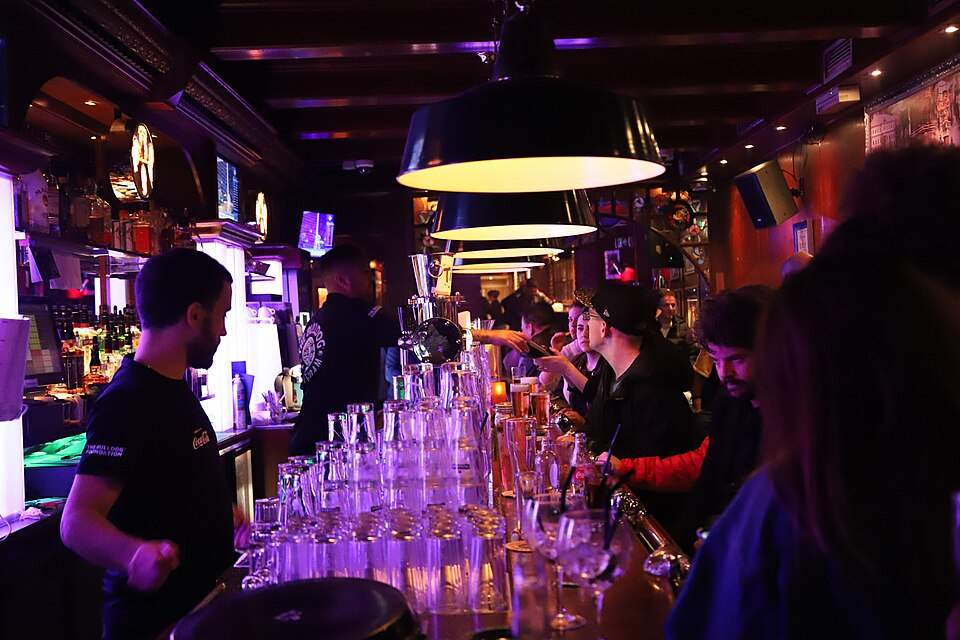The Ultimate Guide to Amsterdam’s Best Nightclubs: Where Legends Are Made

Amsterdam. Just saying the name makes my pulse quicken a bit, and I think that’s probably true for most people who’ve experienced what this city has to offer after dark. There’s something almost magnetic about Amsterdam’s nightlife scene – perhaps it’s the way the city’s liberal spirit translates into pure, unfiltered energy on the dance floors, or maybe it’s how the historic canals seem to amplify the bass lines that pulse through the night.
I’ve spent countless evenings exploring Amsterdam’s club scene, and honestly, I’m still discovering new corners of this incredible nightlife landscape. The city has this remarkable ability to surprise you – one moment you’re in a converted church dancing to techno, the next you’re in an underground bunker where the music seems to come from the walls themselves.
What makes Amsterdam’s nightclub scene truly special isn’t just the venues themselves, though they’re spectacular. It’s the community, the culture, the way music becomes a universal language that brings together people from every corner of the globe. Whether you’re a seasoned clubber or someone who’s just beginning to explore nightlife, Amsterdam offers experiences that will reshape how you think about partying.
Why Amsterdam Rules the Global Nightlife Scene
Let me be honest with you – I’ve partied in cities across the world. London, Berlin, New York, Tokyo. Each has its charm, but Amsterdam? Amsterdam is different. There’s an authenticity here that’s hard to find elsewhere, a genuineness that perhaps comes from the city’s long history of embracing diversity and creative expression.
The Cultural Foundation
Amsterdam’s nightlife doesn’t exist in a vacuum. It’s built on centuries of cultural openness, trade connections, and a spirit of acceptance that you can feel the moment you step into any club. The Dutch approach to nightlife is refreshingly straightforward – good music, good people, good times. No pretence, no unnecessary barriers.
I remember my first night out in Amsterdam, probably fifteen years ago now. I was struck by how welcoming everyone was, how the bouncers actually smiled (imagine that!), and how the crowds seemed more interested in the music than in seeing and being seen. That authenticity has only grown stronger over the years.
The city’s liberal policies have created space for creativity to flourish. Artists, musicians, and party organisers have the freedom to experiment, to push boundaries, to create experiences that might be impossible elsewhere. This freedom translates directly into the clubs – you’ll find venues that are part nightclub, part art gallery, part cultural centre.
Musical Diversity That Actually Means Something
When clubs say they offer “diverse music,” they usually mean they’ll play hip-hop after midnight. In Amsterdam, diversity is real. You’ll find dedicated techno temples, reggae strongholds, indie rock venues, and clubs that seamlessly blend genres in ways that shouldn’t work but somehow do.
The Amsterdam Dance Event (ADE) alone brings over 400,000 visitors to the city each October. But here’s what’s interesting – ADE isn’t just about electronic music anymore. It’s become a celebration of all music, a week where the boundaries between genres blur and magic happens in unexpected places.
I think what sets Amsterdam apart is that the city’s clubs don’t try to be everything to everyone within a single venue. Instead, they specialise, they focus, they perfect their craft. This means you get genuine expertise, real passion, and authentic experiences rather than watered-down attempts at universal appeal. For those particularly interested in electronic music, our comprehensive guide to Amsterdam’s techno scene explores this world in much greater detail.
The International Connection
Amsterdam’s position as a global hub means the talent that comes through here is extraordinary. But it’s not just about big-name DJs – though they certainly come. It’s about how the city nurtures emerging talent, how local artists get platforms alongside international stars, how the scene maintains its grassroots authenticity even as it gains global recognition.
I’ve watched unknown DJs become global sensations, their careers launched from the dance floors of Amsterdam clubs. There’s something about the city’s scene that acts as a launching pad for talent, perhaps because the audiences here are so genuinely engaged with the music rather than just the spectacle.
Beyond the club scene, Amsterdam hosts numerous music festivals throughout the year that complement and enhance the nightclub experience, creating a year-round celebration of music and culture.
What Transforms a Good Club Into a Great One
After years of exploring Amsterdam’s nightlife, I’ve developed a sense for what separates the memorable experiences from the forgettable ones. It’s not always what you’d expect, either.
Atmosphere: The Indefinable Magic
You walk into a club and within thirty seconds, you know. There’s this energy, this feeling that tells you whether you’re in for something special or just another night out. Great Amsterdam clubs have mastered this atmospheric alchemy, though I suspect many of them don’t even realise how they do it.
Take De School, for instance. The moment you enter that converted school building, there’s this sense of transgression, of stepping into something forbidden. The minimalist design doesn’t try to impress you – instead, it strips away everything unnecessary so the music and the crowd can create their own magic. Perhaps that’s the secret: great clubs don’t compete with the experience, they facilitate it.
Then there are venues like Paradiso, where the grandeur of the old church architecture creates this almost sacred atmosphere. Dancing under those soaring ceilings, surrounded by stained glass, there’s this feeling that you’re part of something larger than yourself. The history of the building seems to amplify every beat, every moment.
Sound: The Foundation of Everything
I’m going to be blunt here – bad sound systems ruin everything. You can have the best DJ in the world, the most beautiful venue, the friendliest crowd, but if the sound is muddy or unbalanced, the entire experience falls apart.
Amsterdam’s best clubs understand this absolutely. They invest in proper sound systems, they tune them for their specific spaces, and they maintain them religiously. At Shelter, the sound system isn’t just equipment – it’s practically a religious artefact. The way the bass resonates through that underground space, how every frequency finds its place in the mix, it’s genuinely moving.
The Human Element
Here’s something that might surprise you – the best club experiences often have less to do with the venue itself and more to do with the people who run it. Great clubs have teams that understand hospitality, that recognise they’re not just selling drinks and entry tickets, they’re selling experiences and memories.
I’ve noticed that Amsterdam’s best clubs employ staff who genuinely care about the scene. The bartenders know their regulars, the security teams actually provide security rather than intimidation, and the management understands that their success depends on the community they build, not just the profits they extract.
The Legendary Venues: Amsterdam’s Nightclub Hall of Fame
Let me take you on a journey through Amsterdam’s most essential nightclubs. These aren’t just venues – they’re institutions, each with its own personality, its own tribe, its own place in the city’s cultural ecosystem.
De School: Where Art Meets Underground
De School occupies this fascinating space in Amsterdam’s nightlife landscape – it’s simultaneously one of the most respected techno venues in Europe and one of the most approachable. Set in a former school building (hence the name), it operates as much more than just a nightclub.
During the day, it’s a restaurant and cultural space. Artists work in studios throughout the building, there are exhibitions, talks, events that have nothing to do with nightlife. But when the sun sets, something magical happens. The spaces transform, the music takes over, and suddenly you’re in one of the world’s great techno temples.
The 24-hour licence means the party truly never stops. I’ve walked in on a Tuesday afternoon and found people who’ve been dancing since Saturday night, though they look remarkably fresh considering. There’s something about the space that sustains people, that creates this bubble where normal time doesn’t apply.
What strikes me most about De School is how it’s managed to maintain its underground credibility while achieving international recognition. The programming is consistently excellent – they book DJs you’ve never heard of who blow your mind, alongside established names who play some of their best sets here. The crowd is knowledgeable, passionate, and genuinely there for the music.
Perhaps the only downside is its popularity. Getting in can be challenging, especially on weekends. But that’s part of what makes it special, I suppose. It’s not trying to be accessible to everyone – it’s trying to create perfect experiences for those who truly appreciate what it offers.
Paradiso: Rock and Roll Heaven
If De School is Amsterdam’s techno temple, Paradiso is its rock and roll cathedral. And I mean that literally – this spectacular venue is housed in a 19th-century church, complete with soaring ceilings, ornate details, and stained glass windows that catch the stage lights in the most beautiful ways.
The history of this place is remarkable. It opened as a music venue in 1968, part of the counterculture movement that swept through Amsterdam. Since then, it’s hosted an incredible roster of artists – The Rolling Stones, Nirvana, Prince, David Bowie. The walls have absorbed decades of incredible music, and you can feel it the moment you walk in.
But Paradiso isn’t stuck in the past. The programming is consistently forward-thinking, mixing established acts with emerging artists, rock with electronic music, local talent with international stars. The acoustic properties of the space work brilliantly for both live bands and DJ sets, though there’s something particularly magical about seeing live music in this setting.
Shelter: Underground Excellence
Getting to Shelter is half the adventure. You take a free ferry across the IJ river behind Amsterdam Central Station, then navigate through the base of the A’DAM Tower to find this hidden underground venue. The journey sets expectations, and somehow, Shelter always exceeds them.
This is techno at its purest. The space is deliberately stark – concrete walls, minimal decoration, a sound system that seems to exist in perfect harmony with the architecture. When the music starts, everything else disappears. The outside world, your daily concerns, even your sense of time – it all fades away until there’s nothing but the music and the collective energy of everyone around you.
I’ve never experienced bad music at Shelter. Their booking policy seems to prioritise artistic integrity over commercial appeal, which means you get DJs who are genuinely passionate about their craft rather than just playing crowd-pleasers. The sets tend to be longer, more experimental, more willing to take risks.
AIR Amsterdam: Modern Excellence
AIR Amsterdam represents the newer generation of Amsterdam clubs – technologically sophisticated, professionally run, but still deeply committed to the music and the experience. It’s located in the heart of the city, making it easily accessible, but inside it feels like a world apart.
The design is sleek and modern without being cold. The sound system is genuinely impressive – I remember the first time I heard it, I was struck by how clear everything sounded even in a crowded room. They’ve managed to create acoustics that work whether there are fifty people or five hundred in the space.
Escape: The Grand Experience
Escape is Amsterdam nightlife writ large. This massive venue in the Rembrandtplein can hold over a thousand people, and when it’s full, the energy is absolutely electric. This isn’t intimate or underground – it’s spectacular, theatrical, designed to create those larger-than-life moments that you remember years later.
The production values here are incredible. The lighting systems create genuine visual spectacle, the sound reaches every corner of the multi-level space, and the design creates different experiences in different areas. You can find intimate corners for conversation, or position yourself at the heart of the main dance floor where the energy is most intense.
Club NYX: Joyful Chaos
Club NYX is pure, unapologetic fun. Spread across three floors of a building near Leidseplein, it’s chaotic, colourful, and absolutely committed to creating an environment where people can express themselves however they want.
This is explicitly LGBTQ+ friendly space, but it’s welcoming to everyone who comes with the right attitude. The decoration is deliberately over-the-top, the themed nights are genuinely creative, and there’s an energy here that’s impossible to fake. People come here to celebrate, to be themselves, to dance without inhibition.
Melkweg: Cultural Institution
Melkweg transcends simple categorisation. Yes, it’s a nightclub, but it’s also a concert venue, art gallery, cinema, and cultural centre. Housed in a former dairy (the name means “Milky Way”), it’s been a cornerstone of Amsterdam’s cultural scene since the 1970s.
The programming here is consistently excellent and remarkably diverse. You might see a indie rock concert followed by a techno night followed by a hip-hop showcase, all in different spaces within the same building. The quality is consistently high across all genres and formats.
Radion: Artistic Underground
Radion exists slightly outside Amsterdam’s main club district, which is perhaps appropriate for a venue that exists slightly outside conventional definitions of nightlife. This is a space that’s equally committed to art, community, and music, creating experiences that blend all three into something unique.
Bitterzoet: Intimate Diversity
Bitterzoet is Amsterdam’s proof that great things come in small packages. This intimate venue near the Nieuwmarkt consistently punches above its weight, programming diverse, high-quality events in a space that holds maybe 200 people at capacity.
WesterUnie: Industrial Grandeur
WesterUnie occupies this fascinating space in Amsterdam’s nightlife ecosystem – literally and figuratively. Located in an industrial complex within Westerpark, it’s simultaneously massive and intimate, professional and underground.
Navigating Amsterdam’s Nightlife Like a Pro
After years of exploring Amsterdam’s club scene, I’ve learned that success isn’t just about knowing which venues to visit – it’s about understanding how to navigate the entire ecosystem. Let me share some insights that might save you time, money, and disappointment.
Timing Is Everything
Amsterdam’s nightlife operates on different schedules than most cities, and understanding these rhythms can dramatically improve your experiences. Most clubs don’t really get going until after midnight, and many of the best events don’t peak until 2 or 3 AM. This isn’t just about crowd sizes – it’s about energy and atmosphere.
I’ve learned to embrace this late-night culture rather than fighting it. Start your evening with dinner and drinks in the city centre, perhaps explore some of the excellent cocktail bars or breweries. Use the earlier part of the evening to build energy and anticipation for the main event. For excellent pre-party dining options, check out our guide to the best restaurants near Amsterdam’s nightlife districts.
Dress Codes and Door Policies
Amsterdam’s club scene is refreshingly relaxed about dress codes, but that doesn’t mean anything goes. The general rule is smart casual, but what that means varies significantly between venues.
For underground techno venues like Shelter or De School, the emphasis is more on authenticity than appearance. Wear something comfortable that you can dance in for hours, something that reflects your genuine style rather than what you think you should wear to a club.
For detailed advice on what to wear to each type of venue, our comprehensive Amsterdam club dress code guide breaks down the expectations for every major nightlife district and venue type.
Transportation and Logistics
Amsterdam’s compact size and excellent public transport make club-hopping surprisingly easy, but late-night transportation requires some planning. Trams and metros run until about 12:30 AM on weekdays and 1:30 AM on weekends, after which you’ll need to rely on night buses, taxis, or the city’s excellent bike infrastructure.
Night buses cover most of the city, but services are limited and can be crowded on weekend nights. Taxis are reliable but expensive, particularly for longer journeys. Many locals use bikes even for nightlife, though this requires confidence in cycling after a few drinks and awareness of bike theft risks.
For detailed information about getting around Amsterdam after dark, including night bus routes, taxi services, and safe cycling tips, see our complete Amsterdam late-night transportation guide.
Money Matters
Entry fees in Amsterdam typically range from €10-25, depending on the venue and event. Some places offer early bird discounts or reduced entry before certain times. Pre-sale tickets are almost always cheaper than paying at the door, and they guarantee entry to popular events that might sell out.
Drinks prices vary significantly between venues. Underground clubs and smaller venues tend to be more reasonable, while large commercial clubs charge premium prices. A beer typically costs €4-6, cocktails €8-12. Some venues use cashless systems, which can help with budgeting but require you to load money onto a card.
If you’re watching your budget, our guide to budget nightlife in Amsterdam reveals the best value venues, happy hour deals, and money-saving strategies for partying without breaking the bank.
Cultural Etiquette and Safety
Amsterdam’s club culture is built on mutual respect and inclusivity, but understanding the unwritten rules helps ensure everyone has a good time. Don’t be pushy on dance floors, respect people’s personal space, and remember that not everyone wants to chat while they’re trying to lose themselves in music.
Photography policies vary between venues, but generally, avoid taking photos without permission, especially of other people. Many clubs actively discourage photography to protect the privacy and freedom of expression that makes their atmospheres possible.
Safety in Amsterdam’s clubs is generally excellent, but basic precautions apply everywhere. Keep an eye on your drinks, stay with friends, and trust your instincts if something doesn’t feel right. For comprehensive safety advice, including specific tips for solo travellers and information about local emergency services, read our detailed Amsterdam nightlife safety guide.
Exploring Amsterdam’s Nightlife Districts
Understanding Amsterdam’s different nightlife areas can help you plan more efficient and enjoyable evenings. Each district has its own character, crowd, and specialties.
The Leidseplein area is tourist-friendly with mainstream clubs and bars, while the Nieuwmarkt district offers more alternative and underground venues. The Red Light District has its own unique energy, and areas like Noord (across the IJ) provide cutting-edge venues in former industrial spaces.
For a comprehensive breakdown of each area, including the best venues, transportation links, and what to expect in terms of crowds and music styles, explore our detailed guide to Amsterdam’s nightlife districts.
Beyond the Clubs: Alternative Nightlife
While Amsterdam’s clubs are world-class, the city offers much more for night owls. From speakeasy-style cocktail bars to late-night food markets, comedy shows to art gallery openings, there’s a whole ecosystem of after-dark entertainment beyond traditional clubbing.
Many visitors discover that some of their best Amsterdam nights happen in intimate cocktail lounges or at alternative cultural events that showcase the city’s creative diversity in different ways.
Seasonal Rhythms and Special Events
Amsterdam’s nightlife follows distinct seasonal patterns that are worth understanding if you want to maximise your experiences. Each time of year offers different opportunities and different atmospheres.
Summer: Festival Season
Summer in Amsterdam is magical for nightlife enthusiasts. The longer days and warmer weather create a festival atmosphere that permeates the entire city. Many venues open outdoor terraces, events run later, and there’s a general sense of celebration that makes even ordinary nights feel special.
This is when you’ll find the most outdoor events, from rooftop parties to canal-side celebrations. The city’s parks host concerts and festivals, and many venues expand their programming to take advantage of the increased energy and tourism.
Winter: Intimate Excellence
Winter nightlife in Amsterdam has a completely different character. The focus shifts indoors, creating more intimate, intense experiences. There’s something particularly satisfying about dancing in a warm, crowded club while the winter weather rages outside.
Venues often program more experimental or underground events during winter months, when tourist numbers are lower and they can cater more directly to local communities. This can provide opportunities to experience Amsterdam’s club scene at its most authentic.
Amsterdam Dance Event: The Annual Pilgrimage
ADE in October is when Amsterdam becomes the global capital of electronic music. The entire city transforms, with virtually every venue participating in what becomes the world’s largest electronic music festival and conference.
If you’re serious about electronic music, ADE is unmissable. You’ll see artists you can’t see anywhere else, in venues specifically programmed for the event. But it’s also incredibly busy and expensive, requiring significant advance planning and booking.
Final Thoughts: Why Amsterdam’s Nightlife Matters
After all these words, all these venue descriptions and practical tips, you might wonder why Amsterdam’s nightlife deserves this level of attention and analysis. The answer, I think, lies in what these experiences represent and what they offer to those willing to embrace them.
Amsterdam’s best nightclubs are more than just places to drink and dance. They’re spaces where barriers dissolve, where strangers become friends, where music becomes a universal language that transcends cultural and linguistic differences. In our increasingly divided world, these moments of collective joy and connection feel both precious and necessary.
I’ve seen people find communities in Amsterdam’s clubs, discover music that changed their lives, create memories that lasted decades. These aren’t just commercial transactions – they’re cultural experiences that contribute to personal growth and human connection.
The city’s commitment to maintaining diverse, authentic venues rather than succumbing entirely to commercial pressures creates opportunities that don’t exist in many other places. Where else can you dance to cutting-edge techno in a converted school, experience world-class DJs in a 19th-century church, or discover emerging artists in intimate venues that prioritise music over profit?
Perhaps most importantly, Amsterdam’s nightlife scene demonstrates how cities can create and maintain cultural institutions that serve their communities while attracting global attention and respect. The balance between local authenticity and international appeal, between commercial viability and artistic integrity, offers lessons that extend far beyond nightlife.
So yes, these venues are worth celebrating, worth experiencing, worth supporting. They represent something valuable and increasingly rare – spaces dedicated to joy, creativity, and human connection. In a world that often feels fragmented and divisive, Amsterdam’s nightclubs offer glimpses of what’s possible when we prioritise shared experience and mutual celebration.
Whether you’re a seasoned club veteran or someone just beginning to explore nightlife, Amsterdam offers experiences that will surprise, delight, and possibly transform you. The music is exceptional, the venues are spectacular, and the community is welcoming. But more than that, the city offers something precious – the opportunity to lose yourself in music and find yourself in community, to celebrate individuality while experiencing collective joy.
That’s worth the journey, worth the late nights, worth the occasional disappointment that comes with any adventure worth taking. Amsterdam’s nightlife isn’t just about having a good time – though you certainly will. It’s about experiencing something larger than yourself, something that reminds you why music and dance and community matter, why these simple human activities continue to draw people together across every barrier and boundary.
Come for the music, stay for the magic, and leave with memories that will last a lifetime. Amsterdam is waiting.











